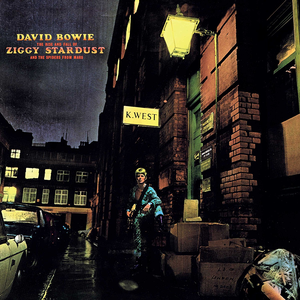
Published on Mar 4, 1997
It may surprise some people that
The Rise And Fall Of Ziggy Stardust And The Spiders From
Mars was not David Bowie’s first record – though it was the
first that truly established him as an art rocker.
Re-released by Rykodisc almost a decade ago, this 1972 release
proved to be a hard one to top for Bowie, though he would come
close sometimes. Still, at the quarter-century mark, there are good
moments as well as some very dated sounds on this one.
Ziggy Stardust is best known for its title track and
“Suffragette City,” as well as the appearance of Mick Ronson (later
to join Mott The Hoople), but sometimes it is the unheralded tracks
that provide the most entertainment on this album.
The opening cut, “Five Years,” takes a few listens to warm up
to, and is a tad bombastic. But the following track, “Soul Love,”
is one of the hidden treasures on the album (featuring saxophone by
one D. Bowie). The slow groove worked up by the song is instantly
appealing, even if the diction isn’t the greatest. Until I looked
at the album cover, I thought the song was “Stoned Love.” Oops.
The best track on
Ziggy Stardust is “Starman,” where the trademark Bowie voice
is given a true chance to come forward in all its glory. A true
piece of art rock that has rarly been equaled, Bowie has rarely
sounded better.
With the exception of the two “hits” from the album, the rest of
the cuts tend to be dated and bland, if not at least listenable.
Part of the distraction from the songs themselves is the
“plink-plink-plink” piano from Ronson – maybe it’s me, but I’d
rather hear some real piano playing rather than Ronson diddling
with the same chord. Listen to the end of “Suffragette City” to
hear what I’m talking about.
And I don’t want to say that
Ziggy Stardust is a bad album, ’cause it’s not. But art
rock, like all art, has its times when it fits in with the rest of
the world picture, and there are times it sticks out like a sore
thumb. (Two words: King Crimson – who are now back in fashion.)
Bowie purists may consider this to be sacrilege, but let’s remember
what was in vogue in 1972 doesn’t stay in fashion for 25 years
non-stop.
Sure, some of the sounds are a tad ancient and repetitive, but
Ziggy Stardust is by no means a poor album. It is one that
needs time to grow on you – I listened to it three times before
writing this, and I’m
still not certain I caught all the nuances. It may not be
the place to start for the new Bowie fan, but it definitely is one
to return to down the road.